
Transcription
LL.B. IV TERMGENDER JUSTICE ANDFEMINIST JURISPRUDENCEPAPER LB-4031Course Materials: Selected and Edited ByProf. Ved KumariProf. Usha TandonMs. Nanditta BatraFaculty of LawUniversity of Delhi, Delhi – 110007January 20171
GENDER JUSTICE AND FEMINIST JURISPRUDENCEPaper LB-4031This course aims at questioning the understanding that law is universal, protectseverybody equally and is accessible to all equally. It uses gender, particularly in relation towomen and persons with non-heterosexuality as examples to show discrimination perpetuatedby law and legal processes. It has long been recognised that law, lawyers and judges areinsensitive and unaware of the problems and perspectives of women resulting in grave injusticeto them in various ways. Orientation and in-service refresher training programmes for lawyersand judges on these aspects have been suggested by all concerned and indeed such trainingprogrammes are being organised too. Law Schools in this scenario have the importantobligation to generate awareness of the gender bias operating in society and legal system inIndia. This course aims to focus on discrimination on the ground of sex and nonheterosexuality in the extant law and judicial decisions. It also explores the jurisprudentialexplanations for the existing state of affairs. It focuses on the patriarchal nature of state andfamily and contemporary feminist and queer debates.It is expected that the students will acquire analytical skills and knowledge to criticallyanalyse functioning of legal provisions and judicial responses from the perspectives of thedeprived and powerless groups in society as an outcome of this course. These skills areimportant not only from the perspective of municipal laws but also in the context ofdiscrimination between the first and third world countries and international law.Prescribed Readings:1. Sarla Gopalan, TOWARDS EQUALITY – THE UNFINISHED AGENDA – STATUS OF WOMENIN INDIA 2001. National Commission for Women.2. Amita Dhanda, Archana Parashar (ed) ENGENDERING LAW ESSAYS IN HONOUR OFLOTIKA SARKAR (1999). Eastern Book Depot.3. Ratna Kapur and Brendia Cossman, SUBVERSIVE SITES: FEMINIST ENGAGEMENTS WITHLAW IN INDIA (1996).4. TOWARDS EQUALITY Report of the Committee of Status in India Government of India(1974).5. Kalapana Kannabhiran (ed), WOMEN AND LAW CRITICAL FEMINIST PERSPECTIVES (SagePublications India 2014)6. Usha Tandon (ed), Gender Justice: A reality or fragile myth (2015).2
CONTENTS(15 weeks course - Total Classes 45-50)TOPIC ONE: INTRODUCTION (7 LECTURES) What is Gender justiceo Notions of sex and gendero Deconstructing ‗Man‘, ‗Woman‘, ‗Other‘o Private-public dichotomy Women in ancient, medieval and modern India: An overview Current status of women:Indicators of status: Difference in - likelihood of survival; female foeticide, assignedhuman worth; and control over property, valued goods and services, working conditions,knowledge and information, political processes, symbolic representation, one‘s body,daily lifestyles, reproductive processes Gender Justice in India: An overviewReadings:1. National Legal Services Authority v. Union of India, [(2014) 1 SCC 1] available at .pdf 2. Moira Gatens, ―A Critique of the Sex/Gender Distinction‖ in A Phillips ed. FEMINISMAND SUBJECTIVITY, pp. 139-154 (Provided in reading material)3. Carol Pateman, ―Feminist Critique of the Public and Private‖ in A Phillips ed.Feminism and Equality, pp. 103-123(Provided in reading material)4. IndiaReportunderCEDAW2011availabaleat vanceVersions/CEDAW-C-IND4-5 en.pdf 5. Sunita Kishor and Kamla Gupta. 2009. Gender Equality and Women’s Empowerment inIndia. National Family Health Survey (NFHS-3), India, 2005-06. Mumbai: InternationalInstitute for Population Sciences; Calverton, Maryland, USA: ICF Macro. Available at http://rchiips.org/nfhs/a subject report gender for website.pdf 6. Lotika Sarkar, ―Women’s Movement and the Legal Process‖ Occasional Paper 24,CWDS,Availableat mensMovement.pdf 7. Nivedita Menon, ―The disappearing body and feminist thought‖ (2011) available at ppearing-body-and-feministthought/ 8. Usha Ramanathan, ―Images (1920-1950) Reasonable Man, Reasonable Woman andReasonable Expectations‖ in Amita Dhanda, Archana Parashar (ed) ENGENDERING LAW,3
tent/a9906.pdf Company.Availableat TOPIC TWO: PATRIARCHY AND FEMINIST JURISPRUDENCE (8 LECTURES) Understanding Patriarchy Issues and contradictions in feminism Sameness and difference debate Liberal feminism Radical feminism Socialist/Marxist feminist approaches9. Kamla Bhasin, What is Patriarchy, Kali/Women Unlimited (2004) (Provided in readingmaterial)10. Ratna Kapur and Brendia Cossman, Subversive Sites: Feminist Engagements with Lawin India 43-75 (1996).11. Alison Jagar ―Introduction : Living with Contradictions: Controversies in FeministSocial Ethics‖ (1994) Westview Press (Provided in reading material)12. Heywood, ―Feminism in Political Ideology: An Introduction‖ pp. 252-265 (2004)Palgrave McMillan. (Provided in reading material)TOPIC THREE: INTERNATIONAL INSTRUMENTS AND WOMEN RIGHTS(4-5 LECTURES) UDHR, ICESCR, ICCPRAvailable at ights/ Available at /ccpr.aspx Available at /CESCR.aspx UN Convention for the Elimination of Discrimination against Women. Available at index.aspx UN Human Rights Council Resolution on Human rights, sexual orientation and genderidentity,2011.Availableat s/LGBTUNResolutions.aspx 13. EXCERPTS: Born Free and Equal: Sexual Orientation and Gender Identity inInternational Human Rights Law (UN Human Rights Office of the High Commissioner)HR/PUB/12/06 (2012)TOPIC FOUR: SEXUALITY AND MORALITY IN LAW ( 6 LECTURES) Indian Penal Code 1860 Rape Laws Adultery Immoral Traffic Prevention Act 1956 read with section 370 IPC Indecent Representation of Women (Prohibition) Act, 19864
14. Ved Kumari, ―Gender Analyses of Indian Penal Code‖ in Amita Dhanda, ArchanaParashar (ed) ENGENDERING LAW Essays in Honour of Lotika Sarkar, pp.139-160(1999). Eastern Book Company. Available at http://www.womenstudies.in/elib/crime ag women/ca gender analysis.pdf 15. Usha Tandon and Sidharth Luthra, ―Rape: Violation of the Chastity or Dignity ofWoman? A Feminist Critique of Indian Law”, FICHL Policy Brief Series No. 51 (2016)availableat http://www.fichl.org/fileadmin/user upload/160615 PBS No. 51 2016 TandonLuthra .pdf 16. Arvind Narrain, ―'That despicable specimen of humanity’: Policing of homosexuality inIndia‖ in Kalpana Kannabiran (ed), CHALLENGING THE RULE(S) OF LAW: COLONIALISM,CRIMINOLOGY AND HUMAN RIGHTS IN INDIA (2008) Sage India (Provided in readingmaterial)17. Vishal Jeet v. UOI, 1990 SCR (2) 861 (Provided in reading material)18. Suresh Kumar Koushal and another v. Naz Foundation, Civil Appeal No.10972 of 2013decided by the Supreme Court on 11 December 2013. Available at me 41070 TOPIC FIVE: ECONOMIC EMPOWERMENT AND LAW ( 8 LECTURES) Labour Laws: Gender protective laws Gender neutral laws Gender corrective laws Law Protecting Women against Sexual Harassment at Work Place The Sexual Harassment of Women at Workplace (Prevention, Prohibition andRedressal) Act 2013 Property Rights of Women19. Flavia Agnes, ―Conjugality, Property, Morality and Maintenance‖ 32-58 in KalapanaKannabhiran (ed), WOMEN AND LAW CRITICAL FEMINIST PERSPECTIVES (SagePublications India 2014) (Provided in reading material)20. Usha Tandon, Gender Bias in the Property Rights of Women under Hindu Law, XXIIDLR, 163 (2000)21. C.B. Muthamma v. Union of India, 1979(4)SCC 260 (Provided in reading material)22. Air India and others v. Nergesh Meerza, 1982 SCR (1) 438 (Provided in reading material)23. Sujata Sharma v. Manu Gupta, 2015 SCC OnLine Del 14424, decided on 22-122015(Provided in reading material)24. p://judis.nic.in/supremecourt/imgs1.aspx?filename 433785
25. Charu Khurana v. UOI ,WRIT PETITION (CIVIL) NO.78 OF 2013 decided by SC onNovember10,2014availableat .pdf 26. D Nagasaila, Gender Equality at Workplace: A Frozen Agenda, in KalapanaKannabhiran (ed), Women and Law Critical Feminist Perspectives (Sage PublicationsIndia 2014)TOPIC SIX: REPRODUCTIVE RIGHTS (6 LECTURES) Indian Penal Code, 1860 Medical Termination of Pregnancy Act, 1971 Maternity Benefits Act, 1964 PC & PNDT Act 199427. Municipal Corporation of Delhi v. Female Workers (Muster Roll) and Another, (2000) 3SCC 224. (Provided in reading material)28. Sabu Mathew George v. Union Of India & Ors., Writ Petition(s)(Civil) No(s).341/2008in Supreme Court of India (Provided in reading material)29. Vinod Soni v. UOI, 2005 Bombay High Court (Provided in reading material)TOPIC SEVEN: LAW PROTECTING WOMEN AGAINST VIOLENCE AT HOME: DOMESTICVIOLENCE, DOWRY HARASSMENT, SATI. (5 LECTURES) Protection of Women against Domestic Violence Act 2005 Dowry Prohibition Act 1961 Commission of Sati (Prevention) Act 198730. S.R. Batra and Anr v. Taruna Batra, (SC 2006) (Provided in reading material)31. D Velusamy v. D Patchaiammal, decided by SC on 21 December 2010 (Provided in readingmaterial)32. Hiral P. Harsora And Ors v. Kusum Narottamdas Harsora 2016 SCC OnLine SC1118, decided on 06.10.2016 (Provided in reading material)33. All India Democratic Women's Association And Janwadi Samiti v. Union of India &Ors., 1989 SCR (2) 66. (Provided in reading material)34. Indira Jaisingh, ―Bringing Rights Home: Review of the Campaign for a Law onDomestic Violence‖ in Kalapana Kannabhiran (ed), WOMEN AND LAW CRITICALFEMINIST PERSPECTIVES (Sage Publications India 2014) (Provided in reading material)TOPIC EIGHT: GENDER JUSTICE AND JUDICIARY (2-3 LECTURES)35. Kalpana Kannabhiran, ―Judicial Meanderings in Patriarchal Thickets: Litigating SexDiscrimination in India” in Kalapana Kannabhiran (ed), WOMEN AND LAW CRITICALFEMINIST PERSPECTIVES (Sage Publications India 2014) (Provided in reading material)It may be noted that the list of reading prescribed and suggested is subject to revision withnew publications and developments.6
PREVIOUS YEAR PAPERSJUNE 20161. (a) ―Gender neutral laws are not really gender neutral as they incorporate male standards andexperiences in the framing of those laws.‖ Explain with the help of legal provisions in supportof the above statement.(b) ―There can be no gender equality in public sphere without first enumerating gender equalityin the private sphere.‖ Give reasons for agreeing or disagreeing with the above statement.2. What do you understand by patriarchy? How does it burden both men and woman?3. What are the difference between paternalistic approach and difference or correctiveapproaches of law while dealing with gender differences between men and women? Explain byreference to legal provisions and judicial decisions.4. What do you understand by ―Third Gender‖? Point out the lacunae in the NALSA judgmentof the Supreme Court providing for OBC status to persons belonging to the ‗third gender‘.5. What are the reasons behind grant of Maternity Leave and Paternity Leave, and Child CareLeave? What is their role in reinforcing or changing gender roles in the private and publicsphere?6(a) What are the salient features of the Convention for Prevention of Discriminationagainst Women?(b) What are the salient features of the Sexual Harassment of Women at Workplace(Prevention, Prohibition and Redressal), Act, 2013?7. In what respects the Protection of Women against Domestic Violence Act different from theremedies provided to women victims of domestic violence under the Indian Penal Code?8. Write short notes on any two of the following:(a) Give reasons for agreeing or disagreeing with the statement that the ever decreasing numberof girls in the 0-6 years is an indicator that no substantive change has happened in the status ofwomen in India.(b) Role of Supreme Court in promoting gender equality.(c) Difference between Radical and Liberal Feminists.Supplementary Exam- September 20161. What is Feminism?(i)―Feminist issues are obviously human issues as human issues invariably turn outto have a feminist dimension.‖ Critically analyse the statement.(ii)Write a feminist critique of Private-Public dichotomy.2. Do you think that PWDV Act, 2005 is based on woman norms and experience? Elaboratewith the help of the definition of Domestic Violence and remedies available under the Act.3. Firestove argued that ―women can achieve emancipation by transcending their biologicalnature and escaping from the ‗curse of Eve‘.‖ Elaborate the statement explaining RadicalFeminism. How is it different from Liberal Feminism?4. Describe the foundational framework of CEDAW, with special reference to the principle ofequality, non-discrimination and State obligations?5. Do you agree that Rape law in India is based on patriarchal norms? Whether 2013Amendment reinforce or dilutes the patriarchal norms to establish the offence of rape?7
6. Vinod and Mamta, a lawfully wedded couple file a write petition challenging theConstitutional validity of PCPNDT, Act, 1994 contending that it violates Art. 21 of theConstitutional of India will they succeed? Decide with the help of judicial precedents.7 (i) Critically analyse ‗Gender Protective‘ and ‗Gender Corrective‘ labour laws.(ii) Describe the definition and scope of Sexual Harassment of Women at work place under theAct of 2013.8. Write short notes on any two:(i) Human rights of LGBT(ii) Gender analysis of the offence of ‗Adultery‘(iii) Women‘s reproductive under MTP Act 1971(iv) Role of Judiciary in promoting Gender Justice8
A CRITIQUE OF THE SEX/GENDER DISTINCTIONMoira GatensIn recent years it has become increasingly prevalent, in texts and papers concerned with sexualpolitics, to encounter the sex/gender distinction This distinction is used in both confused a n dconfusing ways and it is the purpose of this paper to clarify first, what the theoretical basis ofthis distinction is, second, to ascertain whether or not it is a valid or coherent distinction, andfinally, to consider the political effects of the use of this distinction by various political groups.This tripartite task will involve overlapping considerations of feminism's relation to socialistand homosexual politics. The tale of the uncomfortable alliance between feminist and socialistpolitics and feminist and homosexual politics has recently surf aced in a way that is potentiallyproductive for all parties. A critical appraisal of past and continuing alliances is the least oneexpects from radical theorists who value dialectical and historical analysis. It is in this spiritthat the question of the viability of analyses located at the intersection of 'sex' and 'class' can beaddressed. The difficulty of reconciling sex and class, or feminism and Marxism, despite theintervention of a third party, psychoanalysis has been well demonstrated.In this context, the introduction of 'spot-lighting' of gender, as an analytical tool whichpurportedly yields high explanatory returns (as opposed to the barren category of 'sex') offersoccasion for comment. Over the past five years or so, feminist theory, of an Anglo-Americanorientation, has taken up the notion of 'gender' with considerable interest and mixed intent.Influential journals and texts such as m/f, Ideology and Consciousness, Feminist Studies, TheReproduction of Mothering, The Mermaid and the Minotaur and Women's Oppression Today,share if nothing else, this enthusiasm for the notion of 'gender ' as a central explanatory andorganizing category of their account s of the social and familial and/o r discursive constructionof subjectivity. In general, the favouring of the category 'gender' over the category 'sex' isdefended in terms of the 'dangers of biological reductionism'. Theorists who favour analysesbased on gender argue that it is indispensable to see ‗sex' as a biological category and genderas a social one'. Additionally, it would appear that the role of prior or current politicalcommitment to any one of a variety of 'left' politics plays a decisive role in this preference for'gender'. Given that the category 'gender' commands considerable theoretical centrality incontemporary feminist and socialist-feminist theorizing as compared with its peripheralemployment in the early seventies, it is appropriate, at this time, to critically reassess itscredentials.It is in the area of political analysis and practice that the recent proliferation of the sex/genderdistinction becomes most worrying. The distinction has been used by groups as diverse as:Marxists; (usually male) homosexual groups; and feminists of equality.The effect of the use of the sex/gender distinction by the three groups outlined above, thoughclearly they display discernibly distinct political and theoretical motivations, has been toencourage or engender a neutralization of sexual difference and sexual politics. This neutralizingprocess is not novel, it can be traced to nineteenth-century liberal environmentalism where 'reeducation' is the catch cry of radical social transformation. Much of contemporary radicalpolitics is, perhaps unwittingly, enmeshed i n this liberal tradition. A feminism based on9
difference rather than on a priori equality is representative of a decisive break with thistradition.What I wish to take to task in implicit and explicit investigations of gender theory is theunreasoned, unargued assumption that both the body and the psyche are a post-natally passivetabula rasa. That is, for theorist s of gender, the mind, of either sex, is a neutral, passive entity,a blank state, on which is inscribed various social 'lessons'. The body, on their account, is thepassive mediator of these inscriptions. The result of their analyses is the simplistic solution tofemale oppression: a programme of re-education, the unlearning of patriarchy's arbitrary andoppressive codes, and the relearning of politically correct and equitable behaviours and traits,leading to the whole person: the androgyn. It is precisely this alleged neutrality of the body; thepostulated arbitrary connection between femininity and the female .body; masculinity and themale body; and the apparent simplicity of the ahistotical and theoretically naive solution, viz.resocialization, that this paper proposes to challenge.Before proceeding to present a critique of the proponents of the sex/gender distinction I shouldclarify what I take to be the central issue at stake. It would appear that one of the most burningissues in the contemporary women's movement is that of sexual equality is sexual difference. Itis arguable that this debate brings to a crisis both feminism's association with socialism andfeminism's association with (male) homosexual groups. Both associations are often predicatedupon an assumed 'essential or possible equality in the sense of sameness' between the sexes. It isagainst this backdrop of this question that this paper is situated. I would maintain that theproponents of sexual equality consistently mischaracterize and distort the position of thosefeminists who favour a politics of sexual difference. The fault may well lie with those feminist sw h o have not made clear what such a 'politics of difference' amounts to. This paper is anattempt t o a mend this situation and, in addition, to quell, once and for all , the tired (and tiring,if not tiresome) charges of essentialism and biologism so often levelled at theories of sexualdifference. Critics of feminists of difference tend to divide the entire theoretical field of socialenquiry in to an exclusive disjunction: social theory is either environmentalist or it isessentialist.Therefore, and it follows quite logically from this premise, if feminist theories of difference arenot environmentalist then they must be essentialist. The task remains, then, to reopen the fieldof social theory from its forced containment in this disjunction and demonstrate the practicaland theoretical viability of the politics of difference. The latter task shall be effected indirectly,by way of a critique of the proponents of 'degendering '.THE DEGENDERING PROPOSALThe problem of the relationship between sex and gender is, of course, not a new one. Freudgrappled with the problem of finding a suitable definition of masculinity and femininity andtheir relation to men and women in the 'Three Essays' published in 1905.11 However , theauthoritative source for the recent prominence of writings centring on gender is not Freud butRobert J. Stoller, a contemporary psychoanalyst. Stoller published a book titled Sex andGender,12 in 1 968, a text wherein he reports the findings and theses arising out of his researchand involvement with the Gender Identity Research Clinic at UCLA.10
Stoller studies first various biological anomalies (for example, neuters and hermaphrodites) inorder to ascertain the relationship between sex and gender, and second he considers thebiologically nor m al but psychologically disturbed individual (for example, the transsexual). Heclaims, at the completion of his research, to be able to account for the aetiology of both thetransvestite and the transsexual - although his account is self-avowedly more complete in thecase of male transvestites and transsexuals than in the (much rarer) cases of female transvestitesand transsexuals. He claims to be able to account for these psychological anomalies largely interms of the distinction which he develops and systematizes between sex and gender.The explanation is as follows. The biological sex of a person has a tendency to augment, thoughnot determine, the appropriate gender identity of that sex (i .e. masculinity in the case of themale sex; femininity in the case of the female sex). However, a person‘s gender identity isprimarily a result of post-natal psychological influences. These psychological 'influences ongender identity, he claims, can completely override the biological fact of a person's sex andresult in, for example, the situation of the transsexual.Stoller takes the genesis of transsexualism to be wholly social, that is, not biologically orphysically determined. He posits, as the cause of male transsexualism, the mother's attitude tothe child from birth. He report s that in all normal infants there is an initial period of symbiosiswith the mother but that this symbiosis must be broken, particularly in the case of the boy, ifnormal masculinity or femininity as a separate (and in the case of the boy, different) andindependent identity is to develop.Stoller posits, in the case of the male transsexual, an unwillingness on the part of the mother toallow the child to separate from her and develop as an individual. It must be stressed that it isnot only a matter of how long the child is held close to the mother's body but also in whatmanner."' If the mother sees the child as a part of or extension to her own body, then the childwill respond by not developing an identity separate from the mother's (or developing it at acritically late stage) and so, in the case of a male child, will feel himself to be a woman trappedin a male body.The details of Stoller's work are not terribly important for the purposes of this paper. What isimportant is that his work was generally heralded as a breakthrough in the area of sexuality andsocialization. As such it was quickly taken up by feminist theorists as offering theoreticaljustification for the right to equality for all independently of sex. His work has been used byGreer, Millett, Oakley, and more recently by Chodorow, Dinnerstein, and Barrett, to name afew. Millett, writing in 1971, and acknowledging Stoller as support or 'proof ' of her view,offers the speciously reasoned conclusion that since 'Psychosexually (e.g. in terms of masculineand feminine, and in contra-distinction to male and female) there is no differentiation betweenthe sexes at birth. Psychosexual personality is therefore postnatal and learned. Millett'scontention that 'patriarchal ascriptions of temperament and role' to the sexes are arbitrary andleads to the inevitable and naive feminist tactic of the re-socialization of society. She writessince patriarchy's biological foundations appear to be so very in secure, one has some cause toadmire the strength of "socialisation " which can continue a universal condition "on faithalone", as it were, or through an acquired value system exclusively. What does seem decisive in11
assuring the maintenance of the temperamental differences between the sexes is theconditioning of early childhood.Greer and Oakley pursue the same line of reasoning, with idiosyncratic differences.The initial appeal of the implications of Stoller's research, in the late 1960s and early 1970s, isconsistent with the social context of liberal humanism. Education or re-education, at that time,seemed a particularly viable programme for radical social change. Ten years later, however,both the context and the sentiment have ·altered considerably. Previous demands and strategiesof the women's movement have 'back- fired' or proved to be co-optable. It is in this context thatwe need to examine, very carefully, both the 'politics of equality' and sentiments originatingwith the liberal humanists of the eighteenth and nineteenth centuries.The unproblematic assumptions of Stoller's research by contemporary writers, such asChodorow and Barrett, warrants careful scrutiny.In order for a programme of 'degendering' to be successful or even theoretically tenable, onewould have to allow the validity of at least two unargued assumptions central to the thesis putforward by Stoller and assumed by the 'degendering feminists'. These are: i) that the body isneutral and passive with regard to the formation of consciousness, consciousness is primaryand determinant - implicitly a rationalist view; and ii) the important effects of the historical andcultural specificity of' one's 'lived experience' is able to be altered, definitively, by consciouslychanging the material practice of the culture in question. If the validity of these assumptions isallowed then one could claim that cultural and historical significances or meanings receive theirexpression in or are made manifest by an (initially or essentially) neutral consciousness which,in turn, acts upon an (initially) neutral body. One could claim, in addition, that masculine andfeminine behaviours are arbitrary forms of behaviour, socially inscribed on an indifferentconsciousness that is joined to an indifferent body. However, the above-mentioned assumptionswarrant no such validity. To clarify the problem in other words, socialization theory, whichposits the social acquisition of a particular gender by a particular sex is, implicitly, a rationalistaccount, an ahistorical account, and an account which posits a spurious neutrality of both thebody and consciousness. In order to substantiate this position vis-a- vis the resocializationfeminists who uncritically adopt Stoller's account, these two assumptions, outlined above, willbe treated in detail. Although they are obviously interrelated, they will be treated separately forthe sake of clarity and manageability.SEX/GENDER AND THE RATIONALIST CONCEPTION OF THE SUBJECTIt is in the area of the heredity vs environment debate that the extreme difficulty of avoidingconceptualizing the person as a split body / consciousness is most apparent. The sex/genderdistinction is situated in such a debate and, it will be argued, is deeply entrenched in theproblems of confused terminology and conceptualizing that characterize that debate. Thesex/gender distinction is understood, by socialization theorists, as a body /consciousnessdistinction. This is not to suggest that this understanding does not have an immediate,commonsense validity but rather that such an understanding commits its user to a series ofassumptions that, historically, have proved untenable. Theorists who uncritically use the mind /12
body distinction consistently characterize the subject as either predominantly (or wholly)determined by biological forces, i.e. heredity or predominantly (or wholly) determined by theinfluence of social or familial relations, i.e. environment. Both these positions, the latter beingthe one that would best characterize re-socialization feminists, posit a naive causal relationbetween either the body and the mind or the environment and the mind which commits bothviewpoints, as two sides of the same coin , to an a priori, neutral, and passive conception of thesubject. If we conceive of the bod y as neutral and passive and of consciousness as sociallydetermined, then we are at least halfway to a behavioural conception of subjectivity. It isunclear if the behaviourist conception of conditioning, which is based on various experimentalhypotheses in animal ethology, has any valid application in the sphere of human behaviour. Thestimulus-response model of conditioned behaviour assumes a passive and non-signifyingsubject who can be trained to respond appropriately and who can be relied upon to consistentlyrespond appropriately. Psychoanalysis read as a descriptive theory of the constitution ofsubjectivity in (western, industrialized) patriarchal society, seriously undermines thebehaviourist conception of 'conditioning' and the assumed passivity of the subject.The problem of the interrelation and interaction of the body and the mind is by no meansanarchaic theoretical preoccupation. It is out of this problem that psychoanalysis arose. TheFreud of
LL.B. IV TERM GENDER JUSTICE AND FEMINIST JURISPRUDENCE PAPER LB-4031 Course Materials: Selected and Edited By Prof. Ved Kumari Prof. Usha Tandon Ms. Nanditta Batra Facult











